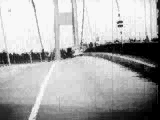Tacoma Narrows Bridge Collapse

see also the following links about the Tacoma Narrows Bridge Collapse:
| Movie formats available- Approx. 8 seconds long |
In this lab we look at a particular mechanical system that ended up in destructive oscillations. Your job will be to examine the information and try to determine the cause of the bridge collapse.
Be mindful of the fact that this is not the only bridge to ever collapse. Some have done so after years of neglect in their maintenance, others wre not structurally capable of withstanding the loads applied to them. This one in particular, however, was newly built. It was designed to expand and contract and move about to some degree.
- Observe the video describing the bridge and its demise.
- As part of your laboratory report, comment on the video, your feelings,
observations, thoughts, as if you were there at the time.
- You have a model in the laboratory which may not exactly represent the
bridge. It is a model (recall just what models are and do) of the cross
section of the road, not the length of the roadway. It does in some manner
represent some aspects of a suspension bridge. The Golden Gate Bridge is a
suspension bridge as well. Assume the model is a rigid platform supported by
two springs of equal spring constant. (Your knowledge of sensitivity to
initial conditions might suggest that this is hardly possible, but assume it
is "close enough for gov't work." See below:
We write down the equations for motion of the bridge using Newton's Second Law:
M ay = - k (y1 + y2) (1) I a = - k L/2 (y2 - y1) (2) We make the small angle approximation:
q = ( y2 - y1 ) / L (3) Your instructor will explain how the resultant differential (this is nonlinear) equations are solved. The result is sinusoidal where:
y1 = A1 sin ( w1t ) and y2 = A2 sin ( w2t ) (4) There are two cases to sonsider. If the bridge goes up and down so that both springs move together; secondly, if the springs move in opposite directions, causing a rotation about the center of the span.
- Case 1: Here both sides of the bridge move in unison. Both edges have
the same frequency of oscillation:
w12 = w22 = w2 = 2 k / m (5) - Case 2: Torsional Mode. The frequencies are:
w12 = w22 = w2 = k L2 / ( 2 mR2) (6)
P = 1 / [ (w - wo )2 + ( Dw / 2 )2 ] (7)
- Case 1: Here both sides of the bridge move in unison. Both edges have
the same frequency of oscillation:
- Comment on your bridge model and compare to the real bridge. How well do they compare? Is this a realistic model? Why or why not? Describe what happened so the reader understands. Make it a cool writeup so "mom" knows what happened. After all, the reader determines your grade.
| Phys 112 Page | ||
| St. Kate's Home Page | Physics Home Page |